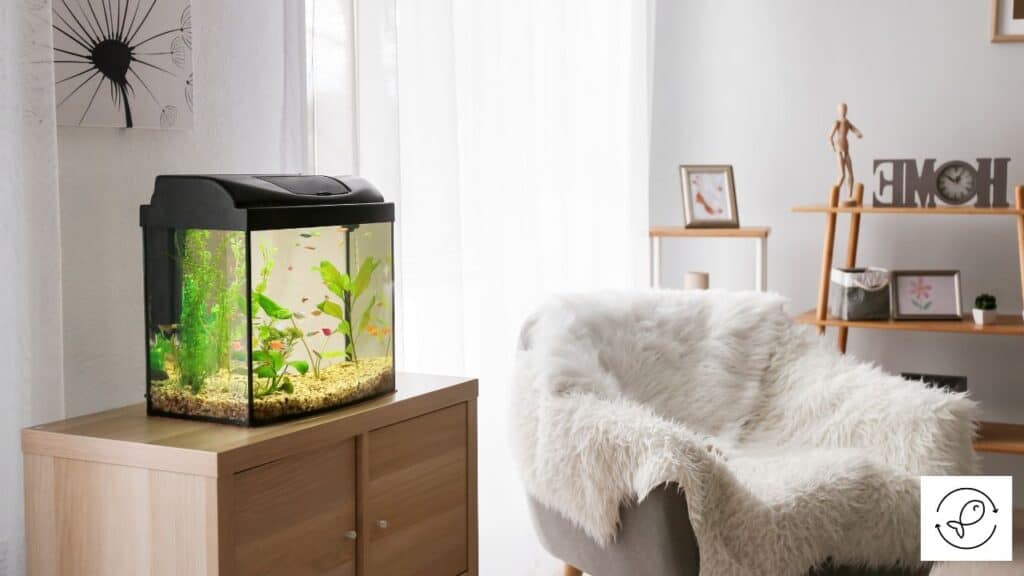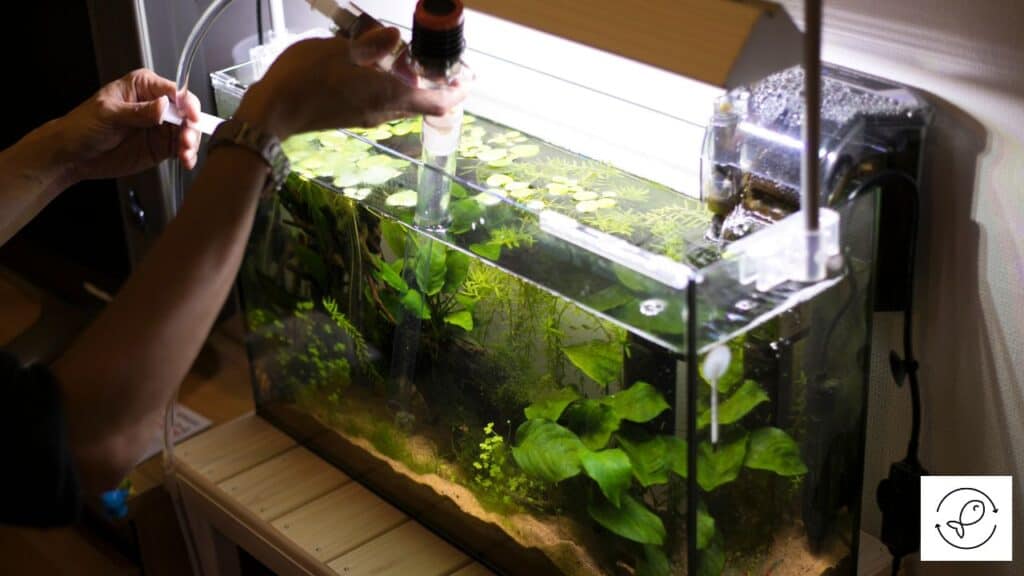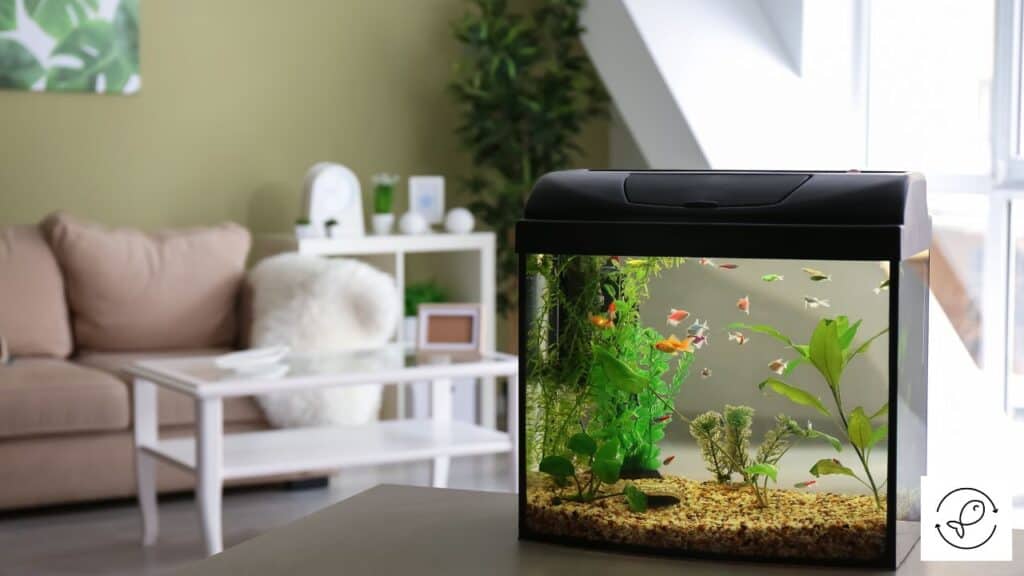Have you ever wondered what is the best spot in your home to place an aquarium?
Here are top tips for choosing the perfect location for your aquarium.
Aquarium Stability
One of the most important factors to consider while choosing the location for your aquarium is the floor’s unevenness and type.
Aquarium stands are designed to distribute the weight of the aquarium tank evenly across the floor.
However, not all floors are created equal. Some of them might be uneven in particular places.
So you will need to use metal shims to level the aquarium stand and provide stability to the aquarium.
It’s also essential to consider the flooring type when placing your aquarium.
Soft floor coverings like carpet, rugs, linoleum, etc., aren’t recommended since they can compress under the tank’s weight, making it unstable.
Hard surfaces like concrete and hardwood are better choices.
If you must place your aquarium on a soft surface like a carpet, a thick flat rug can help distribute the weight and prevent damage to the carpet.
Similarly, you can use rubber furniture leg mats under each leg of the aquarium stand if you have hardwood flooring.
If you are unsure about the soundness of your floor, consult with a contractor before setting up your aquarium.
Taking the time to ensure the soundness of your floor can prevent costly damage and keep your fish safe.
On a related note, make sure that you are also aware of the different types of aquariums before trying to find the perfect place for your aquarium.
Room Temperature
When it comes to aquariums, water temperature is crucial for the health of your fish.
Depending on the fish species you have, you will need to keep the water within certain ideal temperature ranges.
But what happens if the room temperature is too cold?
Your fish can get stressed, which can lead to diseases and be fatal.
To combat this, you will need to invest in a heater for your tank.
However, you must be careful not to overheat the water because this can also harm your fish.
It’s important to monitor the temperature regularly and adjust the heater as needed depending on the fish species.
But what if your room is always chilly, no matter how high you turn up the heat?
In this case, you may need to consider alternative heating methods, such as using two heaters or insulating the room.
Unfinished basements, drafty add-on rooms, and unheated enclosed porches can all present challenges when it comes to maintaining a consistent temperature in your aquarium.
On the other hand, if your room is too warm, you may need to invest in a chiller to keep the water from getting too hot.
It’s also important to consider the location of your tank in relation to central heating or cooling vents.
Placing your tank too close to a vent can cause rapid temperature changes, which can be fatal for the fish.
In addition to temperature, you must also consider the physical aspects of your tank’s location. Is it near a window or door?
Windows

If your aquarium is placed directly in front of a window, the sunlight can raise the tank’s temperature in no time, which can harm the fish.
The sunlight will cause algae overgrowth, which will affect the quality of the water.
To avoid these issues, it’s recommended to keep your aquarium away from windows and direct sunlight.
If you must place your aquarium near a window, consider using thick curtains, blinds, or drapes to block out the direct sunlight.
If the area near the window is drafty, it can also affect the water temperature of the tank.
In this case, you will have to consider using thick blackout curtains to prevent light and air drafts from affecting your aquarium’s water temperature.
Proper ventilation is also important when placing an aquarium.
Good air circulation and ventilation will keep the water temperature consistent and prevent hot or cold spots in the tank.
Doors
Keeping your aquarium near a door can lead to several issues.
If the aquarium is placed near an exterior door, it will be exposed to cold air drafts that can affect the water temperature of the tank.
This can be particularly problematic during the winter when the cold outside air can seep in while the door is open or through the gaps around the door.
This will cause the water temperature to drop considerably.
Similarly, if the aquarium is placed near an interior door, it can be at risk of being bumped into by people passing through.
This can be especially hazardous if the tank is on a stand or if the aquarium has expensive glass decorations.
Another issue to consider is the doorknobs.
If the doorknob is close to the aquarium, it can accidentally bump into the tank while opening or closing the door.
This can lead to spilled water or even cracked aquarium glass.
To avoid these issues, it’s best to keep your aquarium away from interior and exterior doors.
Space
If you are like most people, your home is filled with furniture and other items, so finding the perfect spot for your aquarium can be a challenge.
One thing to keep in mind is that an aquarium can be a great addition to any room in your home.
However, it’s important to make sure that there is enough space for both the tank and any furniture you may have.
If you have a partner or other people in your home, you will want to make sure that they are also comfortable with the tank’s location.
Placing the tank in a common area like the living room or den can be a good option, but make sure that it doesn’t interfere with your daily activities or relaxation.
Finally, consider the size of the tank you are planning to purchase.
Larger tanks will take up more space, so ensure that you have enough room before making a purchase.
By taking furniture and space into consideration, you can find the perfect spot for your aquarium that works well for you.
High Traffic Areas
Placing your aquarium in a high-traffic area like a hallway or entranceway can be stressful for your fish.
The movement of people can stress the fish, which can lead to diseases and even be fatal.
If you have children or pets in the house, you should make sure that the aquarium is placed in a protected space.
Children may get tempted to touch the glass or put objects into the tank, which can harm the fish.
Pets, such as dogs and cats, may try to jump over the aquarium. This can lead to accidental damage to the tank.
Consider creating a cabinet-style stand with a solid base for your aquarium to protect your fish and ensure their privacy.
If you have a family room or den, these may be great places to keep your aquarium.
These areas typically have less traffic and are more relaxed environments.
However, while placing your tank near a TV in these rooms, keep in mind that flashing lights can be confusing for the fish.
It’s best to place the tank at a respectable angle and distance from the TV.
Home Lighting
While you want your fish to have a good view of their surroundings, too much light can be distracting and even harmful to their health.
This is especially true when it comes to overhead lighting.
Most homes have some form of lighting, whether it’s from interior lights or built-in ceiling fixtures.
While these lights can provide a bright and well-lit space, they can also create glare on the surface of your aquarium.
This glare will make it difficult to see your fish.
So, what’s the solution? It’s all about finding the right balance.
You want to provide enough light for your fish to see and thrive, but not so much that it’s overwhelming or harmful.
One option is to use a hood or cover for your aquarium that diffuses the light and minimizes glare.
You can also experiment with different types of bulbs, such as LED or fluorescent, to find the right level of brightness.
It’s important to keep in mind that the location of your aquarium can also play a role in how much lighting affects your fish.
If your tank is placed in a spot with a lot of harsh interior lighting, it may be necessary to adjust the lighting or move the tank to a different location.
Electrical Outlets and Equipment

When setting up your aquarium, electrical outlets are a major consideration.
Aquariums need multiple pieces of equipment to function properly, like a heater, filter, etc. And they need electricity to run.
This means you will need to make sure that your tank is located near more than one electric outlet.
If you have just one electric outlet, use a power strip with a surge protector.
But make sure that these items are in good working condition.
Avoid using extension cords as they can be a short-term solution but daily tripping hazards.
If you aren’t familiar with electrical work, it’s best to leave it to the professionals.
A professional electrician can install a ground-fault circuit interrupter (GFCI) to protect against electrical shock.
This can be particularly important if there is a water leak from your aquarium.
When plugging in the aquarium equipment, make sure that the electric outlet is easily accessible and not too far away from the tank.
Use a drip loop to connect the power cord of the aquarium equipment to the electric outlet.
This will ensure that the water doesn’t come into contact with the electric outlet.
Water Source
Once you have found the perfect spot for your aquarium, it’s important to consider the water source you will use to fill it.
Filling an aquarium can be backbreaking work, so it’s best to choose a location that is close to a water source.
When filling up your tank, remember that water evaporates over time and needs to be topped off.
Weekly water changes are also necessary to ensure the health of your fish.
Therefore, having easy access to a faucet can make this task much easier.
Regarding water options, tap water is the most common choice.
However, bottled water, rainwater, and natural water from streams and wells are also options.
It’s important to note that some sources of water may contain heavy metals or hazardous content.
Large amounts of iron or other metals can be harmful to fish.
Before deciding on a water source, it’s a good idea to sample and test the water to ensure it’s safe for consumption by both humans and fish.
You can contact your local water company or university for information on safe water sources in your area.
Here’s a great place to get a local city water report.
If you are using tap water, it’s important to remove any chlorine with a dechlorinator before adding it to the tank.
Your chosen water source should provide a safe and healthy environment for your fish to thrive.
Accessibility
Cleaning your aquarium is a breeze when you have enough space around it.
You can reach all the corners and spots that need attention.
Plus, you won’t have any trouble with water changes.
Just imagine how easy it will be to use hoses and buckets without making a mess.
Feeding your fish is also simpler with space around the tank.
You can get to the top easily, use feeding tools, and avoid dropping food outside.
And who doesn’t love decorating their aquarium?
With room to work, you can create an amazing underwater world for your fish to enjoy.
Taking care of your aquarium equipment is esseessentialial too.
With space around your tank, you can set up filters, heaters, and lights just right.
It’s also easier to keep an eye on everything and make sure it’s working well.
You will love being able to watch your fish from different angles.
Spotting any problems early on is super helpful for keeping your fish healthy.
Checking things like water temperature and pH levels is also a piece of cake.
In case of emergencies, like a sick fish or broken equipment, having easy access to your aquarium is a big help too.
With plenty of space around the tank, you can act fast and keep your fish happy and safe.

